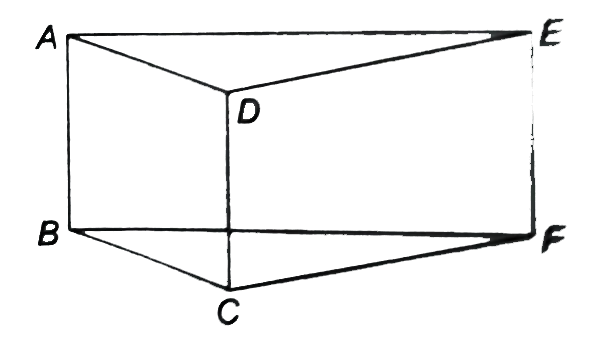A cube has sides of length L=0.300m. It is placed with one corner at the origin ( refer to Fig.2.119).The electric field is not uniform but is given by →E=(−5.00NC−1)xˆi+(3.00NC−1)zˆk.
The flux passing through the surface S5 will be
S2,S4,andS5
S1,S3,S4,andS6
S1,S2,andS3
S2,S3,andS4
The correct Answer is:B
For S1,→A=L2(−ˆj),→E=−5xˆi+3zˆk.
Here →E⊥→A , so ϕs1=0.
For S2,→A=L2ˆk,→E=−5xˆi+3Lˆk.
Here −5xˆi is perpendicular to →A , so no flux due to this component.
ϕs2=(3Lˆk).L2ˆk=3L3=81×10−3Nm2C−1
For S3,→A=L2ˆj,→E=−5xˆi+3zˆk.
Here →E⊥→A , so ϕs3=0.
For S4,→A=−L2ˆk,→E=−5xˆi+0ˆk ("since" z = 0).<br>Herevec _|_ vec(A),sophi_(S_(4)) = 0.<br>ForS_(5) , vec(A) = L^(2) hat (i) , vec (E ) = - 5 L hat(i) + 3z hat(k).<br>Nofluxdue→3 z hat (k) compo≠nt.<br>phi_(S_(5)) = ( - 5 L hat (i)) . L^(2) hat(i) = - 5 L^(3) = - 135 xx 10^(-3) Nm^(2) C^(-1)<br>For S_(6), vec(A) = - L^(2) hat(i) , vec( E) = 0 hat (i) + 3 z hat(k)(sincex = 0).<br>Herevec(E ) _|_ vec(A),sophi_(s_(6)) = 0.<br>Totalfluxthroughthecubeisphi = phi (S_(1) + S_(2) + S_(3) + S_(5) + S_(6))<br>= 81 xx 10^(-3) - 135 xx 10^(-3) = - 54 xx 10^(-3) Nm^(2) C^(-1)<br>Now,phi = ( q_(in))/( epsilon_(0)) or q_(in) = phi epsilon_(0) = - 0.054 epsilon_(0) C
Topper's Solved these Questions
- ELECTRIC FLUX AND GAUSS LAWBOOK - CENGAGE PHYSICS ENGLISHCHAPTER - ELECTRIC FLUX AND GAUSS LAWEXERCISE - Subjective type
7 Videos
- ELECTRIC FLUX AND GAUSS LAWBOOK - CENGAGE PHYSICS ENGLISHCHAPTER - ELECTRIC FLUX AND GAUSS LAWEXERCISE - MCQ s
38 Videos
- ELECTRIC FLUX AND GAUSS LAWBOOK - CENGAGE PHYSICS ENGLISHCHAPTER - ELECTRIC FLUX AND GAUSS LAWEXERCISE - Multiple Correct
8 Videos
- ELECTRIC CURRENT AND CIRCUITBOOK - CENGAGE PHYSICS ENGLISHCHAPTER - ELECTRIC CURRENT AND CIRCUITEXERCISE - Interger
8 Videos
- ELECTRIC POTENTIALBOOK - CENGAGE PHYSICS ENGLISHCHAPTER - ELECTRIC POTENTIALEXERCISE - DPP 3.5
15 Videos
Similar Questions
A suface has the area vector →A(2ˆi+3ˆj) what is the flux erof a uniform electric though the area if the field is a→E=4ˆiN/cand→E=4ˆkN/C ?
View SolutionElectric flux through a surface are 10m2 lying in the xy plane is (if→E=ˆi+√2ˆj+√3ˆkN/C)
View SolutionA 10 C charge is given to a conducting spherical shell, and a-3 C point charge is placed inside the shell. For this arrangement, find the correct statement(s).
View SolutionNine wires each of resistance R are connected to make a prism as shown in figure. Find the equivalent resistance of the arrangement across AB

View SolutionIn the figure shown a conducting sphere of inner radius 'a' and outer radius 'b' is given a charge Q. A point charge 'q' is placed in the cavity of this sphere at distance 'x'(<a) away from the centre. Find the electric field intensity and electric potentials at point P (outside the sphere) at distance r>b. Also find the electric potential at point C

View SolutionA cube has sides of length L=0.300m. It is placed with one corner at the origin ( refer to Fig.2.119).The electric field is not uniform but is given by →E=(−5.00NC−1)xˆi+(3.00NC−1)zˆk.
The surface that have zero flux are
View SolutionA cube has sides of length L=0.300m. It is placed with one corner at the origin ( refer to Fig.2.119).The electric field is not uniform but is given by →E=(−5.00NC−1)xˆi+(3.00NC−1)zˆk.
The flux passing through the surface S5 will be
View SolutionA cube has sides of length L=0.300m. It is placed with one corner at the origin ( refer to Fig.2.119).The electric field is not uniform but is given by →E=(−5.00NC−1)xˆi+(3.00NC−1)zˆk.
The total flux passing through the cube is
View SolutionA cube has sides of length L = 0.300 m . It is placed with one corner at the origin ( refer to Fig.2.119).The electric field is not uniform but is given by vec( E) = ( -5.00 NC^(-1)) x hat(i) + (3.00 NC^(-1)) z hat(k) . The total electric charge inside the cube is
View SolutionA cube has sides of length L . It is placed with one corner at the origin ( refer to Fig.2.119). The electric field is uniform and given by vec€ = - B hat (i) + C hat (j) - D hat(k) , where B , C , and D are positive constants. The total flux passing through the cube is
View SolutionFind V_(ab) in an electric fiels vec E = (2 hat I + 3 hat j + 4 hat k) NC^-1 where vec r_a = (hat I - 2 hat j + hat k) m and vec r_b = (2 hat i + hat j - 2 hat k) m .
View SolutionA surface element vec(ds) = 5 hat(i) is placed in an electric field vec(E) = 4 hat(i) + 4 hat(j) + 4 hat(k) . What is the electric flux emanting from the surface ?
View SolutionIf the electric field is given by vec(E) = 8 hat(i) + 4 hat(j) + 3 hat(k) NC^(-1) , calculate the electric flux through a surface of area 100 m^(2) lying in X-Y plane.
View SolutionA cube of side a is placed in a uniform electric field E=E0ˆi+E0ˆj+E0ˆk. Total electric flux passing through the cube would be
View SolutionA cube of side l is placed in a uniform field E, where E= Eˆi .The net electric flux through the cube is
View SolutionIf the electric field in a region is given by vec(E) = 5 hat(i) + 4 hat(j)+ 9 hat(K) , then the electric flux through a surface of area 20 units lying in the y-z plane will be
View Solution

